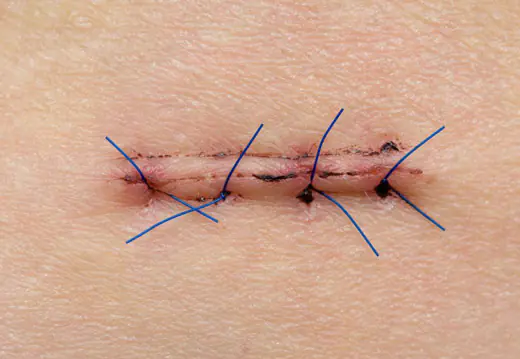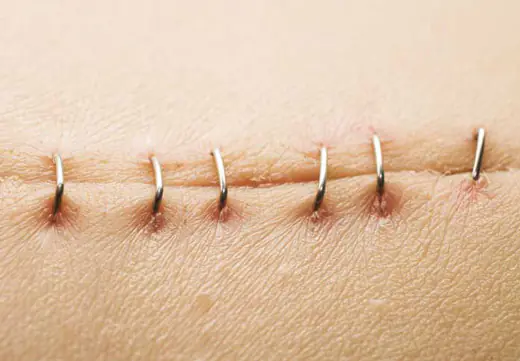After any surgical intervention, a scar always appears. An operation becomes a stressful situation for the body, which activates protective reactions throughout the body. The likelihood of postoperative scars depends on the extent of the intervention, the blood supply to the tissue and the genetics of the person.
Some scars create problems with movement or cause large keloids, which can develop into cancerous lesions.
A scar in a visible place spoils the appearance. There is a need to select clothes that are not always desired. In the area of the scar, the tissues become tight, causing an uncomfortable feeling. The postoperative scar must be removed. This can be done using various cosmetics.
Postoperative scars and scars
The appearance of scars depends on many factors:
- In what direction was the cut made? Human skin stretches differently in each area and direction. There are Langer lines along which it is recommended to make an incision.
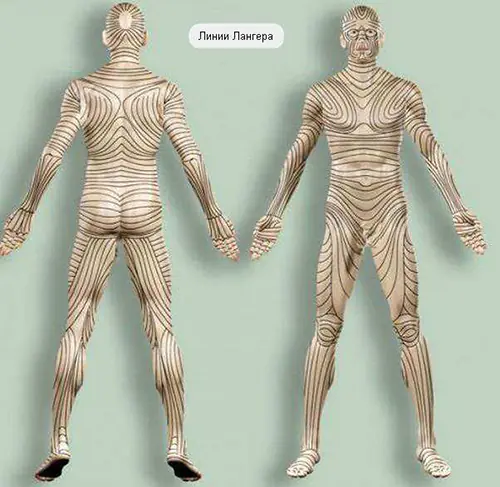
- Was the surgical access located on a mobile area of the skin or over a bony protrusion where the skin is in a tense state? During plastic surgery or planned treatment, incisions are not made in such places. However, when removing foreign bodies (tumor, injury), such features are rarely taken into account.
A scar appears when there is increased production of collagen in the lower layers of the skin. Its amount will determine the size and shape of the future scar.
- The scale of surgical intervention. If the operation was performed on internal organs, then the skin was stretched during the intervention to ensure good access inside. With low blood supply, which can occur as you age, such sprains increase the chances of scarring.
- Method of applying a postoperative suture. Surgeons may use multiple stitches and an intradermal technique where a line is used to continuously connect 2 flaps of skin. If there is some degree of subcutaneous fat, you can only use devices to “tighten” the skin, which guarantees 99% of the appearance of a scar.
- Was there any dehiscence or suppuration? They increase the development of scar tissue.
- The tendency to develop keloids is determined by genetics.
When prescribing a scar remover, the type of defect is taken into account.
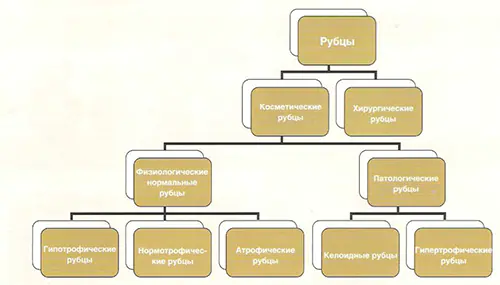
After a violation of the integrity of the skin, two opposing processes are activated in the body:
- active formation of connective tissue;
- splitting of connective tissue.
When these processes are coordinated, a normotrophic scar appears. It does not differ significantly in color from the surrounding tissues and is almost invisible.
With increased dissolution of scar tissue, the scar will take the form of a small depression. It is called atrophic. As a rule, such scars occur when the doctor does not adjust the stitches: removal of warts, moles, papillomas.
If the educational process is more active than the destructive one, then a hypertrophic pink scar appears, protruding above the main surface of the skin. It appears when there is suppuration or trauma to the suture area, in the area of a thick layer of subcutaneous fat.
The use of healing ointments (Levomekol, Solcoseryl, Actovegin) for scars in the postoperative period reduces the likelihood of defect formation. Correction of normotrophic scars is justified by cosmetic means. Keloid scars can be eliminated using more radical methods.
With a genetic predisposition, a white or pink keloid scar forms, protruding above the skin. The surface will be shiny and smooth. The formation of this type of scar begins a couple of months after the sutures are removed. The risk of occurrence increases during adolescence, during pregnancy, with damage to the chest and on dark skin. It is impossible to prevent its appearance.
Removal methods
Only a cosmetologist can choose the correct method of removal. It will take into account not only the type of defect, but also the level of blood supply to the tissues. The most common methods, in descending order:
- cosmetic ointments;
- injections – mesotherapy, Collosta drug, steroids;
- physiotherapy;
- active dermabrasion;
- chemical peeling of the scar;
- vacuum roller massage;
- exposure to liquid nitrogen, laser or current pulse;
- Plastic surgery.
Self-medication with folk remedies is ineffective and often only worsens the situation. There is a loss of precious time that even laser therapy in the future turns out to be ineffective. Only a dermatologist will tell you when to use ointment and when to use more aggressive agents.

Home treatment for scars
At home, you can use cosmetics - various absorbable creams, ointments and special patches. Physiotherapeutic procedures (hydrocortisone, phonophoresis) and compression methods (drugs applied under a pressure bandage) will help improve the result.
Cosmetologists recommend ointments and creams in the following cases:
- for working with normotrophic sutures that cause cosmetic problems;
- for atrophic scars aggravated by furunculosis or chickenpox;
- as preventive measures in the postoperative period;
- for hypertrophic, keloid scars, which prove to be a serious problem.
When scars appear, many people seek to remove them. However, before using any drug, you must visit a doctor to determine the nature of the scar and choose the right device.
To correct the skin, ointments with the following therapeutic effect are used:
- cleansing from bacteria;
- antiseptic effect;
- with biologically active components;
- improving blood circulation and local immunity;
- change in collagen production.
Kelofibrase
The drug is based on urea and sodium heparin. Urea perfectly dissolves tissue, and sodium heparin thins the blood and improves microcirculation. The greatest effectiveness is achieved on fresh scars.
Contractubex
Cosmetic gel based on onion extract, which has an anti-inflammatory effect. It negatively affects the cells that give rise to scar tissue growth. The composition also contains heparin with an anti-inflammatory and softening effect. Allantoin heals wounds and increases tissue ability to bind water.
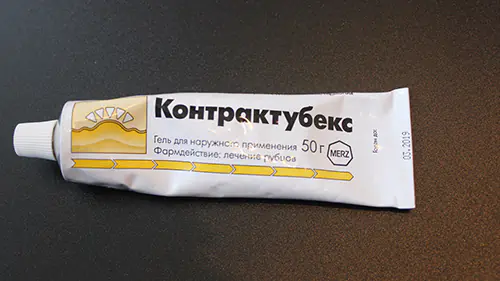
The gel has a light brown color. Can only be used on healed wounds after the healing process has completed as a preventive measure against the appearance of scars. Apply 2-3 times a day for 4-20 weeks. The older the scar, the longer the treatment period. To increase effectiveness, apply a tight, airtight bandage at night. The result directly depends on the systematic use. During use, do not massage, overcool or irradiate the scar with UV rays. Contraindications: individual intolerance.
Kelo-cat
The American drug is available in two forms - spray and gel. It contains polysiloxane and silicone, which together prevent scar tissue from growing. At the same time, the water balance in the tissues is restored, the feeling of tight skin and itching is eliminated.
Dermatix
The product contains abrasive particles in the form of silicon dioxide and polysiloxanes. The healing effect is similar to the previous drug: itching disappears, the skin is moisturized, the appearance of scars and their pigmentation are reduced.
Can be used on scars no older than 6 months. Silicone gel has a transparent structure and is odorless. Dermatix Ultra additionally contains vitamin C.
After the gel dries, a film remains on the surface that does not allow air to pass through. It retains moisture, softens the scar, and reduces pigmentation of the treated areas.
Can be used only after the wound has healed. Before application, the surface is cleaned and dried. After application, wait 5 minutes to dry. Use twice a day for a couple of months. Due to the absence of side effects, it can be used by all categories, including children and pregnant women.
Skargard
The cream contains silicone and hydrocortisone. The actions of silicone are described above, and hydrocortisone is a hormone with an anti-inflammatory effect. Additionally, vitamin E is added to soften scar tissue.

Fermenkol
The natural composition promotes accelerated breakdown of collagen, the fibers of which form the basis of scar tissue. A distinctive feature is that it shows good results in the treatment of not only fresh scars, but old ones (over 6 years). For the latter, it is better to use the gel in combination with electrophoresis.
Mederma
A German-made gel that is effective for treating scars up to a year old. It has a specific smell because it contains Serae onion extract and allantoin. Therapeutic effect:
- regenerates tissue;
- dissolves scar tissue;
- retains moisture;
- fights inflammatory processes;
- stimulates collagen production;
- slows down the formation of fibroblasts;
- removes blood clots.
Apply to a clean and dry area of the scar, rubbing in zigzag movements for 5 minutes until completely absorbed. The treatment period is selected individually. Approved for use during pregnancy.
Clearvin
The ointment is made according to an Ayurvedic recipe. Active ingredients penetrate deeply into tissues and activate new regeneration. The body begins to replace scar tissue with normal skin on its own.
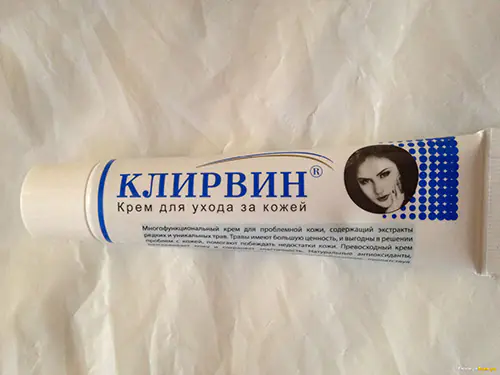
Zeraderm
Silicone gel from a Dutch manufacturer. Contains a high molecular weight silicone compound – polysiloxane. The gel forms a dense film that softens, moisturizes and flattens scar tissue, and also accelerates regeneration and eliminates inflammation. Contains UV filters to protect against affected areas.
Mepiderm patch
The patch allows you to combine the active effects of natural ingredients with a compressive effect. Such a compress provides increased humidity to accelerate the resorption of the postoperative suture.
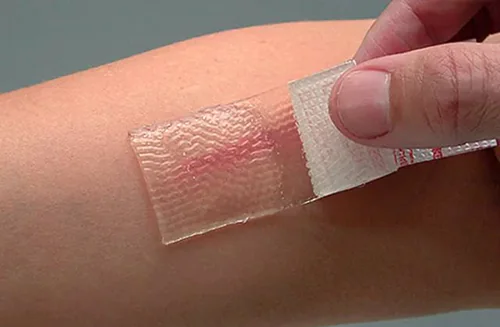
The patch comes in different sizes and colors, allowing you to choose it individually. Before use, water covers are treated with aqueous solutions and dried with a napkin. It is better to remove hair from the area where the patch is applied.
Contraindications
Doctors do not recommend using any cosmetics while there are defects at the scar site:
- herpes;
- redness;
- red vessels are visible;
- eczema – moist areas with blisters and crusts.
Treatment of scars due to allergic skin reactions and infectious diseases is strictly prohibited.
Treatment by a dermatologist
In a cosmetology salon, more radical methods of dealing with scars can be used.
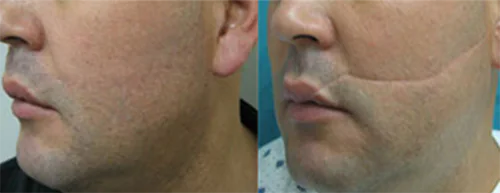
Mesotherapy
Hyaluronic acid, which is a natural filler of the skin, is injected into the scar area. The cocktails also contain a number of vitamins and enzymes. The effectiveness of the method is low.
Glucocorticoid hormones
A synthetic analogue of hormones produced by the adrenal glands is injected into the scar tissue. They have an anti-inflammatory effect, stopping the production of connective tissue, which contributes to the formation of a barely noticeable scar. Suitable for the treatment of keloid and hypertrophic scars.
Peeling
Peeling allows you to remove the surface layer of the epidermis. New healthy layers of skin appear in the treated area. There is no need to worry about deep damage, since the scar consists of connective tissue with no germ layer. Peels can be mechanical or chemical.
Cryotherapy
The area is exposed to liquid nitrogen to cause necrosis of pathological tissue. Healthy skin begins to form at the site of the scar. However, the depth of impact cannot be 100% controlled. To obtain a visible result, several procedures will be required, which can be performed only after complete healing (14 days). The new wound will be moist, increasing the risk of infection.
Laser resurfacing
It is the most popular and effective method of removing postoperative scars. A small burn is applied to the area of the defect. During the healing process, healthy cells begin to displace scar tissue.
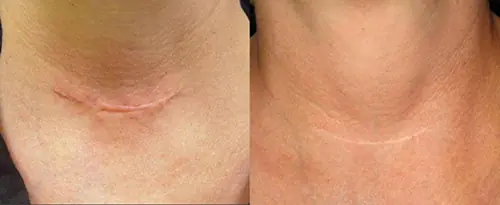
A complete correction consists of several procedures. Each healing takes about 10 days. The wound is covered with a dry crust, which eliminates the possibility of infection.
Surgery
Large hypertrophic and keloid scars are removed by plastic surgeons. They remove scar tissue, and then apply a cosmetic suture or cover it with a flap of their own skin. The flap must be pre-prepared to preserve its blood supply.
Scars of various origins can cause not only cosmetic, but also physiological problems. They are able to reduce muscle activity, growing and darkening over time. There are several methods to combat them. Doctors recommend starting with natural cosmetics, which should be selected by a cosmetologist.
A scar often remains after surgery on the abdomen, arm, face, neck and other parts of the body. It is a cosmetic defect and creates discomfort. On average, it takes from six months to a year for the suture to completely heal and a scar to form. To reduce it, special ointments, creams and gels containing collagen are used.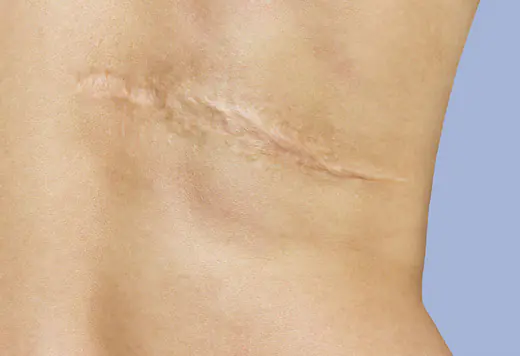
Features of tissue scarring after surgery
A postoperative scar has the appearance of fibrous tissue, which differs in structure and properties from healthy soft or muscle tissue. For this reason, it often causes pain, it can itch, become inflamed and red. Depending on the type of seam and its size, the methods of getting rid of the scar differ.
In the International Classification of Diseases (ICD), this pathology is assigned code L90.5 - scar conditions and skin fibrosis. The resulting wound during surgery takes a long time to heal, as a result of which a mark is formed, which in the future may change slightly. The formation of a scar after surgery goes through 4 stages, presented in the table:
| Stage | Duration | Peculiarities |
| Suture healing | Up to 10 days | The wound is connected by granulation tissue |
| Easy divergence of the formed scar due to the tension of nearby localized tissues. | ||
| Fibrillogenesis and the formation of a fragile scar | From 10 to 30 days | Reduction in the number of vessels and cell elements. |
| Increase in collagen and elastic fibers. | ||
| The extreme areas of the wound are connected by an immature scar, which is easy to stretch. | ||
| Formation of a durable scar | Up to 3 months | Increased content of fibrous structures. |
| Reduction of cellular elements and blood vessels. | ||
| Transformation | From 4 months to a year | Scar tissue matures slowly, and the vessels practically disappear. |
| Pallor of the scar. | ||
| In the middle of the stage, the scar becomes dense and hard, and a method by which it can be removed can be figured out. |
Mostly scars form after appendectomy in a child or adult, during which the appendix is removed. This type of surgery is common and leaves a noticeable scar on the abdomen.
Types of postoperative scars
In medicine, it is customary to divide postoperative scars into 4 types:
Keloid. It resembles a tumor-like neoplasm, which, like a mushroom, hangs over the skin. The color varies from rich pink to bluish. It has a lumpy and dense surface. Such a scar after surgery is larger than the damaged surface of the epidermis. Causes itching and burning sensations in the patient, inflammation often occurs and pain is felt. Doctors have still not been able to establish the nature of the appearance of such a neoplasm after surgery. Predisposing factors include genetics affecting keloidosis and the location of injury or surgery.
Hypertrophic. A rough and hard scar that rises above the top layer of the skin. It often peels off and leads to the formation of trophic ulcers.
Predisposing sources to its formation are identified:
- deep burns or lacerations;
- untimely or poor-quality surgery;
- localization of the scar in active areas that are often touched;
- genetic factor.
Atrophic. Scars are less noticeable because they are flesh-colored or whitish. They are the result of injury to a large area of skin or fatty tissue.
Physiological or normotrophic. After the wound heals, the mark remains invisible and does not protrude above the upper layer of the epidermis. Soon redness and an increase in size are noted, and sensitivity increases. After 2-3 months, the scar will again become almost invisible. This is how superficial wounds heal after surgery performed by an experienced surgeon. During surgery, the doctor tries to cut the tissue along natural folds so that cosmetic defects do not occur in the future.
We recommend reading:
Cosmetology procedures
Treatment of scars after surgery is carried out using cosmetic procedures performed in the office of a dermatocosmetologist. These methods include:
- Dermabrasion. During the procedure, the upper part of the epidermis is polished and excess connective tissue is removed. Using this method, the relief of the skin is leveled. Used for hypertrophic scars. Dermabrasion is divided into the following types:
- Diamond, during which diamond chips are used.
- Microdermabrasion. It is possible to get rid of the scar after surgery using a stream of microgranules.
- Laser. Removal is carried out using a laser beam.
- Mechanical. You can remove an old scar after surgery using a cutter.
- Exposure to cold. Treatment with this method is particularly popular and is known as cryodestruction. The healthy tissue around the scar is exposed to low temperature, which causes a sharp spasm, causing the healing process. Some dermatologists do not favor this method of removing scars after surgery, since it is likely to increase the size of fibrous tissue.
- Beech therapy. The size of the old suture can be reduced by irradiating the affected area. The negative side of this technique is the hyperpigmented stripe, which remains after manipulation in more than a quarter of patients.
Hardware techniques and surgery
Removal of postoperative scars is carried out by hardware and surgical excision. It is possible to get rid of the scar through abdominoplasty, during which the aesthetic proportions of the abdomen are restored. Plastic surgeries are also performed to eliminate a cosmetic defect. To avoid complications when removing a scar, you should contact a professional plastic surgeon. The following surgical methods are used to eliminate a keloid scar:
- Plastic surgery using local fabrics. During surgical manipulation, nearby localized healthy tissue is used. A technically simple and affordable method. The treatment process is carried out in a hospital and takes no more than a week.
- Expander plastic. Required when getting rid of large areas of scar tissue. During the procedure, the removed suture is replaced with expanders, silicone bags that are inserted under the skin and stretched. This procedure is especially effective in the formation of scars after surgery on the scalp.
- Plastic surgery with free skin grafts. Transplantation is carried out layer by layer or with splitting of the thin upper layer of the skin.
Medication
Removal of postoperative scars is also carried out using folk remedies and medications at home. Treatment in this way can only be done after consultation with a doctor, who will recommend the best drug to eliminate the scar. The following medications are used:
- "Diprospan". Refers to glucocorticosteroids. It is necessary to spread the cream preparation onto the damaged area of the skin several times a day. The medicine is used in the form of injections injected into the injured area of epithelial tissue.
- "Kelofibrase." The area of scar tissue will be reduced if you use a product containing urea and sodium heparin. The substances have anti-inflammatory and regenerating effects. It is recommended to apply immediately after scar formation, since old scars are not easily removed.
- "Kontraktubeks". The medicine is available in the form of a gel containing onion extract. After using the drug, the growth of cells that affect the growth of scar tissue is inhibited. Thanks to the allantoin included in the composition, the wound heals faster after surgery and the ability of tissues to bind water increases.
- "Kelo-cat." Contains silicone and polysiloxane, which form a film on the top of the scar. It prevents scar tissue from growing. When using the product, unpleasant symptoms are eliminated: itching, burning, inflammation. Similar drugs are Dermatix and Skargard.
- "Clearwin." The ointment includes natural substances that penetrate into the deep layers of tissue. By enabling regeneration, it replaces the skin with healthy one.
When removing a scar after surgery, they use a special Mepiderm patch, which is simply glued to the affected area of the skin.
How to avoid scar inflammation after surgery
In order for the scar to begin to heal normally and decrease in size, it is necessary to carefully monitor it and prevent an inflammatory reaction. Do not comb or peel off the resulting crust, as such measures will lead to infection and inflammation. It is recommended to cover the scar with a plaster, especially if it occurs in a child. Do not touch the wound often with dirty hands. If a postpartum scar is noted, then to prevent its divergence and inflammation, refrain from lifting heavy objects. After a shower, soak the scar with a paper towel.
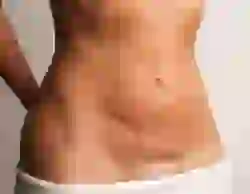
As is known, the formation of a scar after damage to the skin during injuries and operations is a biological pattern and is perceived by both surgeons and patients as an inevitable evil. For practice, it is important that the final formation of the scar is completed only 6-12 months after the operation is performed, and at the same time the quality of the scar begins to be assessed by the patient.
Surgical treatment of injuries or life-threatening conditions is one thing; then the surgeon first of all thinks not about the beauty of the future scar, but about uncomplicated wound healing. In this case, as a rule, no complaints are made against the operating specialist, and this is generally fair.
Another thing is aesthetic surgery, when the main goal of the surgeon is to improve the patient’s appearance and minimize scars. By agreeing to the operation, the patient also agrees to the appearance of scars after it. But in this case, their characteristics become the most important indicator of the quality of the doctor’s actions, who, even before the intervention, is obliged to inform the patient in detail about the possible nature of future scars. This information allows the patient to agree or refuse the operation, and after it, if dissatisfied with the characteristics of the scars, to make a claim to the surgeon.
How does wound healing normally occur?
Wound healing is a biological process that lasts about a year and ends with the formation of a mature scar. However, subsequently the tissues that form the scar can change, although to a minimal extent.
Stage 1 of healing – postoperative inflammation and epithelization of the wound (1-10 days after surgery). A distinctive feature of this stage is the connection of the edges of the wound with granulation tissue, and not with a scar. Therefore, when the sutures are removed on days 7-10, the wound can easily open under the tension of the surrounding tissues. To obtain a minimal scar width in the future, this tension must be eliminated or neutralized by applied sutures.
Stage 2 – active fibrillogenesis and the formation of a fragile scar (10-30 days after surgery). Young granulation tissue quickly matures, which is accompanied by a decrease in the number of vessels and cellular elements, on the one hand, and an increase in the number of collagen and elastic fibers, on the other. At the end of this stage, the edges of the wound are already connected by a young, fragile scar, which is relatively easy to stretch and is clearly visible due to the large number of vessels it contains.
Stage 3 – formation of a durable scar (30-90 days after surgery). The number of fibrous structures in the scar increases significantly, and their bundles acquire a certain orientation in accordance with the dominant direction of load on the scar. The number of cellular elements and vessels in the scar tissue is significantly reduced, the scar becomes less bright and less noticeable. During this phase, external forces have a significant influence on the characteristics of the scar. Thus, with longitudinal stretching of the scar, additional formation and clearer orientation of collagen and elastic fibers occur in its tissue, and to a greater extent, the stronger the stretching. If in a patient the processes of fibrillogenesis are initially enhanced and prevail over collagenolysis, hypertrophic and even keloid scars may form, regardless of the direction of stretching.
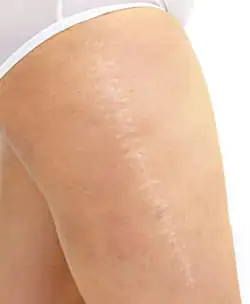
Stage 4 – final transformation of the scar (3-12 months after surgery). It is characterized by increasingly slow maturation of scar tissue with the almost complete disappearance of small blood vessels from it. The scar fades even more. It is important to note that in most cases, it is in the middle of the 4th period (usually after 6 months) that skin scars can be assessed as formed and the possibility of their correction can be determined.
What determines what the scar will be like?
The external characteristics of the scar are influenced primarily by the following factors:
- the location of the wound and, in particular, the degree to which its long axis corresponds to the force lines of the skin (in short, along wrinkles and natural folds the scar will be thinner and less noticeable);
— method of surgical wound closure and the quality of its implementation, including the experience of the surgeon;
— efficiency of drainage (for extensive and complex-shaped wounds).
The patient’s age, immune status, and heredity play a role.
As a rule, scars normally do not cause any physical sensations in their owner. The appearance of signs of tissue irritation in the scar area (tingling, burning) is typical for hypertrophic (protruding above the skin), and especially for keloid (overgrown) scars. But unpleasant subjective sensations acquire practical significance only if they reduce the patient’s quality of life. In such cases, treatment is indicated - scar correction.
Treatment of scars after surgery
In recent years, many attempts have been made to find a way to non-surgically correct scars: from injections of aloe or vitreous to topical treatment of scars with pepsin with hydrochloric acid, thiosinamine, salicylic acid, hydrocortisone and its analogues, or creazote oil. Unfortunately, neither approach showed significant results.
But it still makes sense to use additional methods that improve the quality of scars in the postoperative period. First of all - peace and absence of irritating movements. Under resting conditions, a scar of smaller volume and with more favorable characteristics is formed. It would be advisable to fix the edges of the sutured wound with strips of adhesive plaster, which can well keep this area of skin from stretching for quite a long time (up to 2-4 weeks). This will prevent early expansion of the developing scar. Depending on the specific conditions, the patch strips can be used during the entire period of formation of a durable scar (3-6 months from the date of surgery). They are changed by the patient himself when the patch begins to peel off. In this case, the skin should be washed with soap, wiped dry and sealed with a new strip of plaster. If signs of irritation appear on the skin, stop using the patch until the skin condition is completely normalized.
In order to improve the quality of scars during their formation, special silicone coatings, silicone plates, patches and medicinal gels can be used (for example, Contractubex to prevent the formation of pathological scars).
If signs of hypertrophic or keloid scar formation appear, therapeutic methods such as injection injection of glucocorticosteroids into scar tissue (drug "Kenalog-40").
Unfortunately, the personal experience of every surgeon indicates that it can be difficult, and sometimes impossible, to achieve a significant effect in the correction of scars even through surgery. At this stage of development of medicine, its methods are not able to completely eliminate the scar, or radically influence the general mechanisms of the formation of human scar tissue. The surgeon has the opportunity to exclusively locally influence individual characteristics of the scar, and often with very limited effectiveness. The doctor can only excise the scar and sew it up again, this time in a more qualified manner. For large scars, transplant a skin flap or use dermotension to create excess skin and cover the scar with it.
The doctor makes a decision about scar correction only after assessing the likelihood of treatment effectiveness. A positive decision is made by the surgeon after obtaining the patient’s informed consent, taking into account his psychological status and realistic expectations. An important role in this process is played by detailed informing the patient about the future appearance of the scar with demonstration of similar scars on the monitor screen.

When a surgeon, for one reason or another, cannot offer the patient surgery to improve the quality of the scar, a way out can sometimes be applying a camouflage tattoo to a scar. But this solution is not suitable for everyone, although it is used quite often. And in some cases, tattooing gives excellent results, since the scar is replaced by decoration. But you shouldn't get a tattoo on your cesarean scar if you're going to have another child.
If surgical excision of the scar is not necessary, you can try to smooth the surface of the scar using conservative methods.
Conservative correction of tissue relief disorders in the scar area
A scar is noticeable not only because its tissue differs in appearance from the surrounding skin. Very often, the leading role in the occurrence of an aesthetic defect is played by disturbances in the relief of tissues. It is the unevenness in the damaged area that can make even a small scar more noticeable and thereby significantly worsen the aesthetic characteristics of the appearance. How to make a scar less noticeable?
Disturbances in the microrelief of the scar can be corrected by medicinal, physiotherapeutic methods and biological fillers.
Medicines to make the scar less noticeable
Corticosteroids. Intraruminal steroids remain the mainstay of scar treatment. Corticosteroids reduce scar formation by reducing the synthesis of collagen, glycosaminoglycans, inflammatory mediators, and fibroblast proliferation during wound healing. The most commonly used corticosteroid is triamcinolone acetate at a concentration of 10-40 mg/ml Kenalog, administered into the injured area by needle injection at intervals of 4-6 weeks. The effectiveness of such an introduction as a monomodel and as an addition to the scar excision procedure is very high. Topical corticosteroids are also widely used, which are applied daily directly to the formation. Complications of corticosteroid treatment include atrophy, telangiectasias, and pigmentation disorders.
Immunomodulators. A new method in the treatment of keloid and hypertrophic scars is interferon therapy. Interferon injected into the suture line after excision of a keloid scar can prophylactically prevent relapses. It is recommended to administer 0.5–1.0 million IU every other day for 2–3 weeks, then 0.1–0.5 million IU 1–2 times a week for three months.
Drugs that reduce hyperproliferation of connective tissue cells. A classic remedy for the treatment of scars is hyaluronidase; it breaks down the main component of the interstitial substance of connective tissue - hyaluronic acid, which is a cementing substance of connective tissue, and thus increases tissue and vascular permeability, facilitates the movement of fluids in the interstitial spaces. Hyaluronidase reduces tissue swelling, softens scars and evens out their surface, preventing the formation of scars. Preparations containing hyaluronidase: Lidaza and Ronidase. Lidase solution (1 ml) is injected near the site of the lesion under the skin or under scar tissue. Injections are made daily or every other day; the course of treatment consists of 6–10–15 or more injections. If necessary, repeat courses are carried out at intervals of 1.5–2 months.
Another enzyme-based drug is Longidaz a. "Longidase" is a chemical compound of hyoluronidase with polyoxidonium. The combination of the enzymatic activity of hyaluronidase with the immunomodulatory, antioxidant and moderate anti-inflammatory properties of polyoxidonium provides a wide range of pharmacological properties. It is most effective to use the drug "Longidaza" by ultraphonophoresis or phonophoresis. For ultraphonophoresis, Longidase 3000 IU is diluted in 2–5 ml of gel for ultrasound therapy. The impact is carried out with a small ultrasonic emitter (1 cm 2), with an ultrasound frequency of 1 MHz, intensity 0.2–0.4 W/cm 2, in continuous mode, exposure time 5–7 minutes, course of 10–12 procedures daily or every other 1 day. Using the phonophoresis method (1500 Hz), 3000 IU of Longidase is administered daily (total exposure time 5 minutes, course - 10 procedures). It is also possible to administer the drug inside the scar:
— for small keloid and hypertrophic scars: Longidaza 3000 IU once every 7 days for a total course of 10 injections into the scar;
- for keloids and hypertrophies with a large area of damage: Longidase 3000 IU 1 time in 7 days inside the scar in a course of 8-10 injections, at the same time intramuscular administration of Longidase 3000 IU No. 10.
A well-known drug that inhibits the pathological proliferation of connective tissue cells and at the same time has an anti-inflammatory effect is the Contractubex gel. "Contractubex" is used in surgery and cosmetology in the treatment of postoperative and post-burn scars, including rough scars that impede movement and keloids, as well as stretch marks (striae) after childbirth or after sudden weight loss. Apply to the scar area, 0.5 cm of gel on a scar surface with an area of 20-25 cm² on average 2 times a day.
An enzyme preparation of 9 collagenolytic proteases, Fermenkol cream is a fundamentally new proteolytic preparation. The anti-scar effect of Fermenkol is based on the reduction of excess extracellular matrix in scar tissue.
The effect when using anti-scarring agents is observed approximately 3 weeks after the start of use of the product and the optimal result is usually achieved after 2-3 courses of electrophoresis or phonophoresis, 10-15 sessions or applications for 30-60 days.
Physical and physiotherapeutic procedures to make the scar less noticeable:
Resurfacing will give a positive result for small superficial scars or pinpoint scars due to the consequences of acne. A scar with a smooth surface is much less noticeable than a scar with micro-elevations or depressions.
Laser grinding. The surface treated with a laser beam becomes smoother after epithelialization. Laser resurfacing has all the advantages due to the selectivity and precision of its impact on small areas of the skin (up to 1 sq. mm). The operation is usually performed under general anesthesia, since local administration of even a minimal volume of anesthetic solution can radically change the surface texture of the skin in the scar area. A surgical erbium laser is used. Epithelization of the treated surface occurs within 5-7 days.
Cosmetic procedures, aimed at external correction of the defect (peelings, mesotherapy, dermabrasion) do not give a noticeable result on large scars, but they can make small scars less noticeable.
Silicone plates and bandages. Allows you to smooth the surface of a small scar. Ineffective on hypertrophic scars and keloids.
X-ray therapy (Bucca rays). It is based on the action of ionizing radiation on connective tissue, causing swelling and destruction of collagen fibers and fibroblasts. X-ray therapy is prescribed up to 6 radiation sessions with an interval of 6–8 weeks at a single dose of up to 15,000 R.
Cryosurgery. Cryosurgical agents, such as liquid nitrogen, attack the microvasculature and cause cell death through the formation of intracellular crystals. Typically, 1–3 freeze-thaw cycles of 10–30 seconds are sufficient to achieve the desired effect. It is used only for hypertrophic and keloid scars.
With a formed scar with a duration of up to 12 months, it is possible to carry out treatment with all methods, and with a long-existing scar (more than 12 months), only aggressive methods are effective: injection of corticosteroids into the affected area, excision, radiation therapy, Bucca therapy, laser therapy.
Severe disturbances in the relief of the skin surface in the scar area are clearly visible and are most often caused by the following reasons:
1. Inaccurate comparison of the edges of the wound when applying sutures. Small inaccuracies will smooth out over time. In other cases, surgical correction with precise alignment of the wound edges is necessary.
2. Reducing the fat layer at the level of the scar with its deepening. Options to solve the problem:
- liposuction of the tissues surrounding the scar (fat tissue next to the scar is removed),
— lipofilling in the area of the depression (a layer of adipose tissue is added under the scar),
- introduction of gels and other fillers (the effect is good, the disadvantage is that the gel can migrate and is gradually eliminated from the body),
- plastic with local fabrics.
3. A deep tissue defect at the level of injury, forming a significant depression. Here, depending on the conditions, tissue complexes with a non-axial type of nutrition (on a wide tissue pedicle), as well as island or free flaps can be used.
Moving the scar to a hidden area
The surface of any scar differs from normal skin, and the severity of this problem is most pronounced when the scar is located on open areas of the body. In the vast majority of cases, it is impossible to move the scar to another place, however, there are exceptions to this rule. Thus, during plastic surgery of the anterior abdominal wall, the removal of a significant area of skin along with the scars located on it (for example, after surgery for appendicitis, interventions on the abdominal and pelvic organs) leads to the fact that a new horizontal scar is located in an already relatively hidden area - in the lower abdomen. A prerequisite for performing such operations is the presence of significant excess skin on the abdomen (for example, in women who have given birth).
An important argument in the patient’s consent to surgery is the simultaneous improvement in the shape of the torso.
In general, normotrophic (properly healed) scars generally do not require surgical correction, unlike hypertrophic (protruding) and keloid scars.
Correction of hypertrophic scars
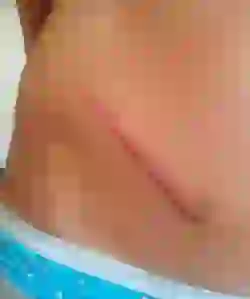
In order to reduce the width of the hypertrophic scar (along with excision), to eliminate functional limitations and reduce unpleasant subjective sensations, it is used z-scar plastic surgery. Due to the fact that the main local cause of hypertrophy of scar tissue is longitudinal stretching of the scar, the main principle of its surgical correction is to change the direction of the scar through plastic surgery with opposing triangular flaps, also known as z-tissue grafting. The scar is excised and triangular flaps are formed along each edge of the wound, after moving which the wound takes on a zigzag shape. When the shape of the wound changes, it lengthens, which sharply reduces the influence of the longitudinal stretch factor. At the same time, a compensatory counter movement of the edges of the wound occurs, which increases their tension in the transverse direction.
Injections of the drug "Kenalog-40" with lidocaine into the tissue of the developing scar have a direct effect on the mechanism of scar formation, reducing the intensity of fibrillogenesis. It is advisable to start administering the drug from the 3rd week after the operation, the effect will be most pronounced. However, even at a later date you can get a good effect. The course of treatment is 3-4 injections, which are repeated at intervals of 5-7 days. Possible complications - when the drug spreads to the tissues adjacent to the scar, atrophy of the subcutaneous fatty tissue and skin may develop with the formation of depressions.
For small hypertrophic scars, conservative treatment is used - the above listed physical and physiotherapeutic methods, medications.
Correction of keloid scars
Due to the fact that the main reason for the formation of keloid scars is the body’s abnormal reaction to injury, expressed in a special course of wound healing processes with the formation of a keloid, attempts to influence a keloid scar only by surgical methods, unfortunately, are ineffective.
If we talk about excision of keloid scar, then it is possible, but only if the surgeon has sufficient knowledge and practical skills.
The most effective treatment method in this case is injection into the scar tissue drug "Kenalog-40", which allows you to significantly reduce the volume of the outer part of the scar (sometimes to normal size). In the postoperative period, an additional course of glucocorticosteroid therapy is advisable in all cases.
Can also be carried out locally X-ray therapy (Bucca rays), which in itself can give positive results in the treatment of keloid scars.
Can also be used in the complex treatment of patients with keloid scars. gel "Kontraktubeks" and balneotherapy.
Of great importance immobilization of keloid scar, including the use of special silicone coatings.
Thus, at present, keloid scars remain one of those diseases for which treatment with known methods is not sufficiently effective.
One can only hope that in the near future medicine will find ways to influence these processes so that they result in the formation of normal tissue.



